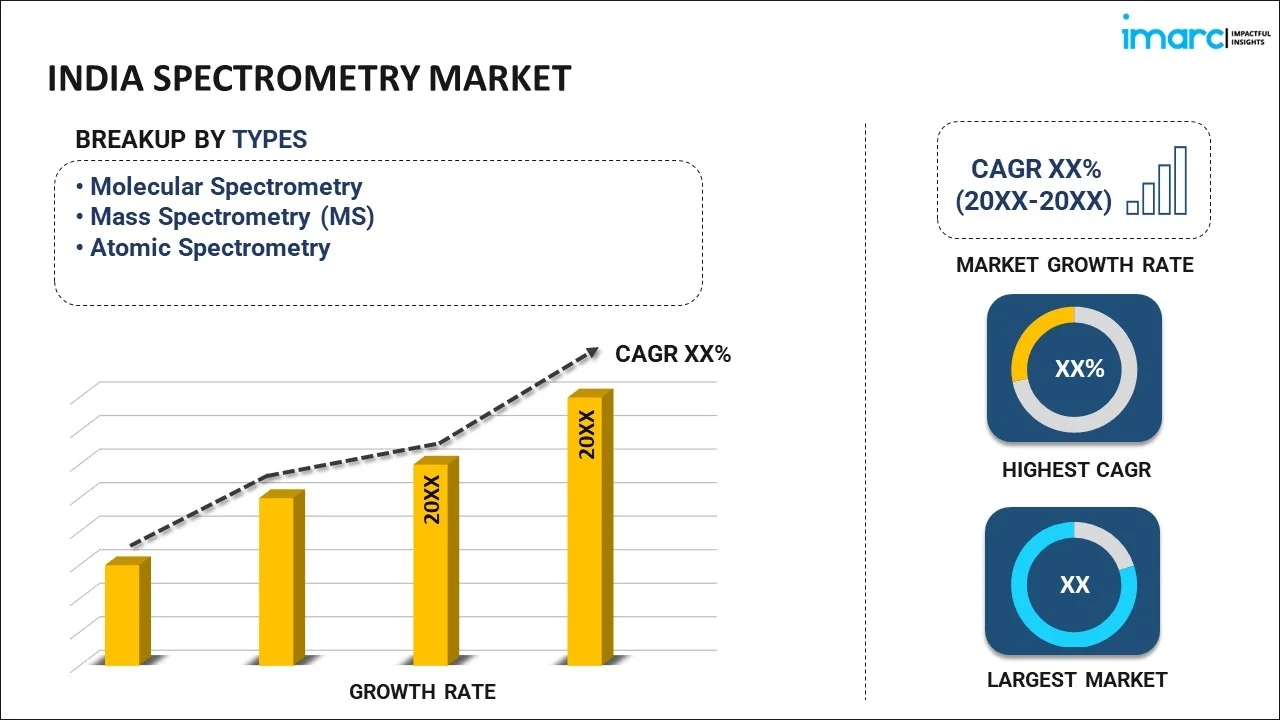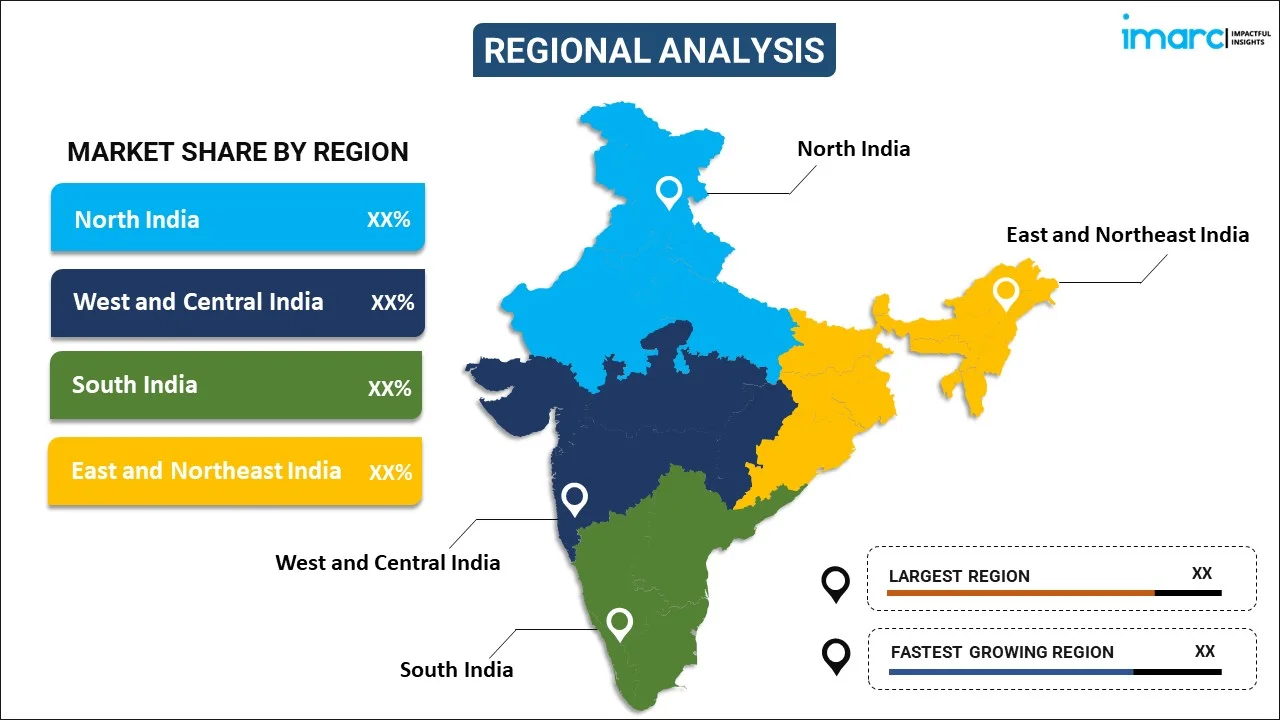
India Spectrometry Market Report by Type (Molecular Spectrometry, Mass Spectrometry (MS), Atomic Spectrometry), Product (Instrument, Consumables, Services), Application (Proteomics, Metabolomics, Pharmaceutical Analysis, Forensic Analysis, and Others), End User (Government and Academic Institutions, Pharmaceutical and Biotechnology Companies, and Others), and Region 2025-2033
Market Overview:
India spectrometry market size reached USD 544.5 Million in 2024. Looking forward, IMARC Group expects the market to reach USD 914.7 Million by 2033, exhibiting a growth rate (CAGR) of 5.91% during 2025-2033. The continuous advancements in spectrometry technologies, such as mass spectrometry, infrared spectroscopy, and nuclear magnetic resonance (NMR) spectroscopy, which contribute to improved sensitivity, accuracy, and resolution, are driving the market.
|
Report Attribute
|
Key Statistics
|
|---|---|
|
Base Year
|
2024
|
|
Forecast Years
|
2025-2033
|
|
Historical Years
|
2019-2024
|
| Market Size in 2024 | USD 544.5 Million |
| Market Forecast in 2033 | USD 914.7 Million |
| Market Growth Rate 2025-2033 | 5.91% |
Spectrometry is a powerful analytical technique that plays a pivotal role in various scientific disciplines, particularly chemistry and physics. It involves the measurement and interpretation of spectra, which are unique patterns of light emitted, absorbed, or scattered by substances. Spectrometry enables scientists to elucidate the composition, structure, and properties of materials by studying their interaction with electromagnetic radiation. One of the most common applications of spectrometry is in the field of mass spectrometry, which allows for the precise determination of the molecular mass of compounds. This technique is crucial in identifying unknown substances and elucidating complex molecular structures. Additionally, infrared spectrometry provides valuable insights into the vibrational modes of molecules, aiding in the characterization of functional groups.
India Spectrometry Market Trends:
The spectrometry market in India is propelled by several factors that collectively contribute to the industry's robust growth. Firstly, the increasing demand for advanced analytical technologies has spurred the adoption of spectrometry across various sectors. Furthermore, the escalating emphasis on R&D activities in the pharmaceutical and biotechnology industries has created a substantial market pull for spectrometric solutions. Additionally, the expanding applications of spectrometry in environmental monitoring and food safety have heightened the need for precise and reliable analytical tools. Moreover, the technological advancements in spectrometric instruments, such as the development of compact and portable devices, have broadened the market's appeal. This innovation allows for on-site analysis, addressing the growing preference for real-time monitoring in diverse industries. The rising awareness and stringent regulations pertaining to product quality and safety further drive the demand for spectrometry solutions in quality control processes. Furthermore, collaborations between academic institutions, research organizations, and industry players are fostering knowledge exchange and technological advancements in spectrometry. This collaborative approach accelerates the market's evolution, offering novel opportunities for growth and diversification. In conclusion, the dynamic interplay of these interconnected factors underscores the vibrant trajectory of the spectrometry market in India.
India Spectrometry Market Segmentation:
IMARC Group provides an analysis of the key trends in each segment of the market, along with forecasts at the country level for 2025-2033. Our report has categorized the market based on type, product, application, and end user.
Type Insights:

- Molecular Spectrometry
- Visible and Ultraviolet Spectroscopy
- Infrared Spectroscopy
- Nuclear Magnetic Resonance (NMR) Spectroscopy
- Others
- Mass Spectrometry (MS)
- MALDI-TOF
- Triple Quadrupole
- Quadrupole-Trap
- Hybrid Linear Ion Trap Orbitrap
- Quadrupole-Orbitrap
- Atomic Spectrometry
- Atomic Absorption Spectroscopy (AAS)
- Atomic Emission Spectroscopy (AES)
- Atomic Fluorescence Spectroscopy (AFS)
- X-ray Fluorescence (XRF)
- Inorganic Mass Spectroscopy
The report has provided a detailed breakup and analysis of the market based on the type. This includes molecular spectrometry (visible and ultraviolet spectroscopy, infrared spectroscopy, nuclear magnetic resonance (NMR) spectroscopy, and others), mass spectrometry (MS) (MALDI-TOF, triple quadrupole, quadrupole-trap, hybrid linear ion trap orbitrap, and quadrupole-orbitrap), and atomic spectrometry (atomic absorption spectroscopy (AAS), atomic emission spectroscopy (AES), atomic fluorescence spectroscopy (AFS), x-ray fluorescence (XRF), and inorganic mass spectroscopy).
Product Insights:
- Instrument
- Consumables
- Services
A detailed breakup and analysis of the market based on the product have also been provided in the report. This includes instrument, consumables, and services.
Application Insights:
- Proteomics
- Metabolomics
- Pharmaceutical Analysis
- Forensic Analysis
- Others
The report has provided a detailed breakup and analysis of the market based on the application. This includes proteomics, metabolomics, pharmaceutical analysis, forensic analysis, and others.
End User Insights:
- Government and Academic Institutions
- Pharmaceutical and Biotechnology Companies
- Others
A detailed breakup and analysis of the market based on the end user have also been provided in the report. This includes government and academic institutions, pharmaceutical and biotechnology companies, and others.
Regional Insights:

- North India
- West and Central India
- South India
- East and Northeast India
The report has also provided a comprehensive analysis of all the major regional markets, which include North India, West and Central India, South India, and East and Northeast India.
Competitive Landscape:
The market research report has also provided a comprehensive analysis of the competitive landscape. Competitive analysis such as market structure, key player positioning, top winning strategies, competitive dashboard, and company evaluation quadrant has been covered in the report. Also, detailed profiles of all major companies have been provided.
India Spectrometry Market Report Coverage:
| Report Features | Details |
|---|---|
| Base Year of the Analysis | 2024 |
| Historical Period | 2019-2024 |
| Forecast Period | 2025-2033 |
| Units | Million USD |
| Scope of the Report | Exploration of Historical and Forecast Trends, Industry Catalysts and Challenges, Segment-Wise Historical and Predictive Market Assessment:
|
| Types Covered |
|
| Products Covered | Instrument, Consumables, Services |
| Applications Covered | Proteomics, Metabolomics, Pharmaceutical Analysis, Forensic Analysis, Others |
| End Users Covered | Government and Academic Institutions, Pharmaceutical and Biotechnology Companies, Others |
| Regions Covered | North India, West and Central India, South India, East and Northeast India |
| Customization Scope | 10% Free Customization |
| Post-Sale Analyst Support | 10-12 Weeks |
| Delivery Format | PDF and Excel through Email (We can also provide the editable version of the report in PPT/Word format on special request) |
Key Questions Answered in This Report:
- How has the India spectrometry market performed so far and how will it perform in the coming years?
- What has been the impact of COVID-19 on the India spectrometry market?
- What is the breakup of the India spectrometry market on the basis of type?
- What is the breakup of the India spectrometry market on the basis of product?
- What is the breakup of the India spectrometry market on the basis of application?
- What is the breakup of the India spectrometry market on the basis of end user?
- What are the various stages in the value chain of the India spectrometry market?
- What are the key driving factors and challenges in the India spectrometry?
- What is the structure of the India spectrometry market and who are the key players?
- What is the degree of competition in the India spectrometry market?
Key Benefits for Stakeholders:
- IMARC’s industry report offers a comprehensive quantitative analysis of various market segments, historical and current market trends, market forecasts, and dynamics of the India spectrometry market from 2019-2033.
- The research report provides the latest information on the market drivers, challenges, and opportunities in the India spectrometry market.
- Porter's five forces analysis assist stakeholders in assessing the impact of new entrants, competitive rivalry, supplier power, buyer power, and the threat of substitution. It helps stakeholders to analyze the level of competition within the India spectrometry industry and its attractiveness.
- Competitive landscape allows stakeholders to understand their competitive environment and provides an insight into the current positions of key players in the market.
Need more help?
- Speak to our experienced analysts for insights on the current market scenarios.
- Include additional segments and countries to customize the report as per your requirement.
- Gain an unparalleled competitive advantage in your domain by understanding how to utilize the report and positively impacting your operations and revenue.
- For further assistance, please connect with our analysts.
 Inquire Before Buying
Inquire Before Buying
 Speak to an Analyst
Speak to an Analyst
 Request Brochure
Request Brochure
 Request Customization
Request Customization




.webp)




.webp)












